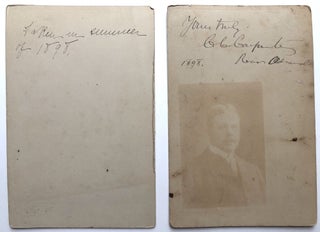2 1898 cabinet photos of Rear Admiral C. C. Carpenter, Portsmouth NH, the year before he committed suicide
2 cabinet photos (both measure, including the mount boards, 6.5 x 4.25 inches), very good, light wear, one inscribed on the back by Carpenter, the other with the note "taken in summer of 1898." Information on Carpenter that follows taken from an obituary from a Boston newspaper of April 2, 1899. "Admiral Carpenter was called from the retired list to active duty in charge of the navy yard at Portsmouth, N. H., during the war, while Commodore Remey was on duty at Key West. Admiral Carpenter had a brilliant record. Admiral Carpenter, for the last six weeks, was an inmate of the Adams Asylum, in the Jamaica Plain District, and at the earnest request of his family, details have been withheld from the public He shot himself in the head. For a number of years previous to his retirement, Admiral Carpenter suffered severely from nervous disorders and soon after being released from service went under medical treatment. He had apparently recovered, but six weeks ago there ciame a relapse and he was again placed in the asylum. Again he I seemed to improve and the family had hopes that he would be himself again. Charles Carpenter wasi born in Greenfield, Mass., in 1834. He was appointed midshipman from this State in 1850 and was attached to the sloop Portsmouth of the Pacific squadron, from 1851 to 1855. He was in the Naval Academy from 1855 to 1856, was promoted to passed midshipman in the. latter year. Later he served on- the steam frigates Merrimac, Roanoke, Colorado and Dolphin. He was made a Lieutenant in 1858 and attached to the steamer Mohawk, which captured the slaver Wildfire off the coast of Cuba, with 500 slaves on board. Carpenter was transferred in 1802 to the steamer Flag of the South Atlantic squadron, and was soon promoted to Lieutenant Commander. He next saw service on the monitor Catskill of the South Atlantic blockading fleet, and was on board during the operations and attacks upon the defenses of Charleston in 1863. After the close of the war he went to the Asiatic station with the sloop Hartford. His first command was the steamer Wyoming of the same squadron, serving on her for one year and then returning to this country. For two years he was stationed at the Portsmouth navy yard, during which time he was Commander. Sea duty alternated with duty at Portsmouth for ten years following. In 1883 he was Commander of the Hartford, which carried the English and American eclipse expedition in 1883 to the Carolina Atoll. From 1888 to 1890 he commanded the ship Wabash at the Charleston navy yard, finally being transferred to Portsmouth as Captain of the yard and later as Commandant. He received his commission as Commodore in 1883 and as Rear Admiral a year later. As Commander of the Asiatic squadron in 1894 he saw many of the naval movements of the Chinese-Japanese war. Under his orders was fired the first and only shot by an American man-of-war at a Chinese ship, thereby enforcing demands of this Government and averting the impending breach of relations between the United States and China. His action was commended by our Government. Admiral Carpenter was retired in 1896, but during the Spanish war was recalled to act as Commandant of the Portsmouth navy yard in place of Commodore Remey." One can certainly see the deep sadness in his eyes in these two photos. Very Good. Item #H14730
Price: $50.00


